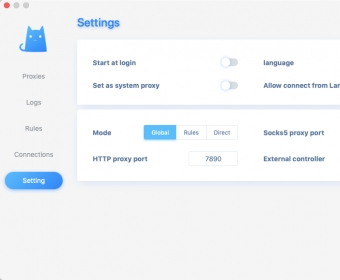

Global: all packets will be forwarded to a single endpointĭirect: directly forward the packets to the Internet ‘ ‘: bind all IP addresses 192.168.122.11: bind a single IPv4 address “”: bind a single IPv6 address bind-address: ‘‘ This is only applicable when allow-lan is true Set to true to allow connections to the local-end server from HTTP(S) and SOCKS4(A)/SOCKS5 server on the same portĪuthentication of local SOCKS5/HTTP(S) server Transparent proxy server port for Linux (TProxy TCP and TProxy UDP) Transparent proxy server port for Linux and macOS (Redirect TCP and TProxy UDP) Port of SOCKS5 proxy server on the local end Port of HTTP(S) proxy server on the local end

When a request, or say packet, comes in, Clash routes the packet to different remote servers (“nodes”) with either VMess, Shadowsocks, Snell, Trojan, SOCKS5 or HTTP protocol. In this chapter, we’ll cover the common features of Clash and how they should be used and configured.Ĭlash works by opening HTTP, SOCKS5, or the transparent proxy server on the local end. YAML is designed to be easy to be read, be written, and be interpreted by computers, and is commonly used for exact configuration files. You can now move forward to the next chapters of this wiki in which we’ll cover the configuration syntax of ClashĬlash uses YAML, YAML Ain’t Markup Language, for configuration files.
#Clashx ipv6 install
$ go install binary is built under $GOPATH/bin You can either grab the pre-built binaries of Clash from or build locally.Ĭlash requires Golang 1.17 or a higher version. While we strive to improve it and keep it accurate, This documentation is still in the works. This wiki will cover both versions of Clash.
#Clashx ipv6 software

#Clashx ipv6 update
Designing a complete Ethernet stack is too big of a task to complete within one project, however the stack should be easy to extend and update in the future. This project explores the possibilities of making a flexible Ethernet stack by using Clash.


 0 kommentar(er)
0 kommentar(er)
